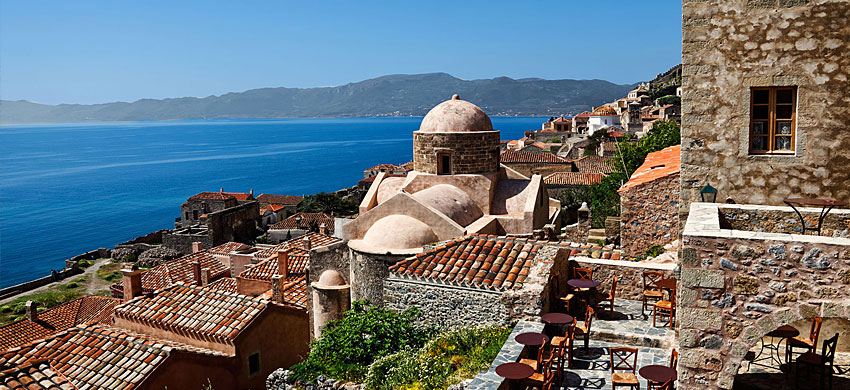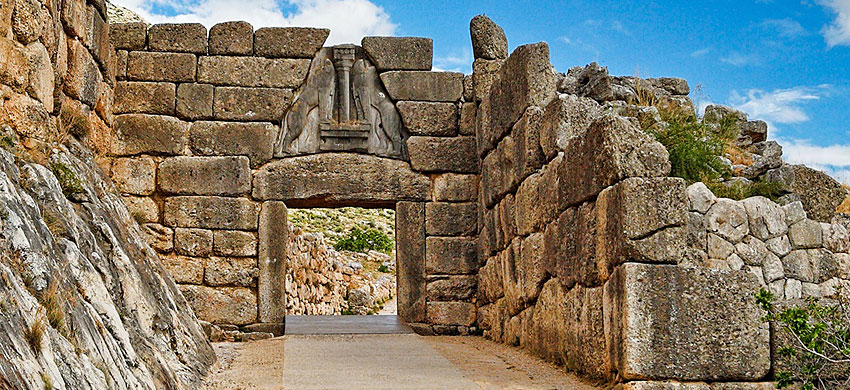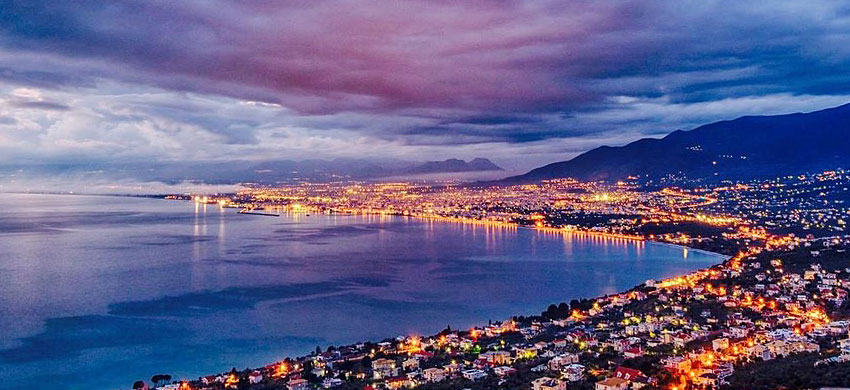


The Peloponnese region is a piece of Greece, not only geographically but also historically and culturally.
Among its rugged mountains and green valleys rise the cities of ancient myth and some of the most important archaeological sites in Europe, declared UNESCO World Heritage Sites: Olympia, birthplace of the Olympic Games; Mycenae, cradle of the homonymous civilization; Argos, reign of Agamemnon; Sparta, bitter rival of Athens; Arcadia, an area of bucolic fame and beauty.
Even the Middle Ages has left evident traces in the Peloponnese, with characteristic fortified villages, sometimes in a vertiginous position overlooking the sea, while along the coast have arisen recently seaside resorts around enchanting beaches that have nothing to envy to the most famous Greek islands.
For a different kind of Greece where you can find the best of Greek tourism – culture, clear sea, good food, nature walks – this year stay on the mainland and explore the Peloponnese.
The Peloponnese occupies the southern part of mainland Greece and since 1987 has become an administrative region, uniting the so-called peripheral units of Arcadia, Argolida, Corinthia, Messinia and Laconia.
Of considerable historical-geographical importance, with a predominantly mountainous territory, the Peloponnese is bathed by the Ionian Sea to the west and by the Aegean Sea to the east.
The literal translation of the name “Peloponnese” would be “island of Pesopo”: until 1893 it sounded a bit strange because the Peloponnese was to all intents and purposes a peninsula.
In that year, however, was realized the Corinth Canal, which cuts the thin isthmus that bound the Peloponnese to the rest of mainland Greece, making it to all intents and purposes an island.

An obligatory stop for tourists visiting the Peloponnese is Olympia, the ancient city-sanctuary famous throughout the world for being the place where the first Olympic Games in history were held, dedicated to Zeus, and where even today, after more than 4000 years, the Olympic torch is lit to kick off modern sports competitions.
Ancient Olympia is undoubtedly the most famous tourist resort of the Peloponnese and one of the most important archaeological sites in Greece. It is located just 500 meters from the modern city, surrounded by greenery along the valley of the river Alphaeus.
Little is left of the grandiose ancient city, with its temples, stadiums, celebratory monuments and lodgings for athletes, but the power of the myth is such that walking among the ancient ruins it will not be difficult for you to imagine the roar of the spectators cheering the athletes, the shout of triumph of the winner, his glory and his satisfaction.
The modern Olympia is not as fascinating, but it is still a nice town where it is pleasant to spend a few hours wandering through its streets, lined with cafes and souvenir stores.

Mycenae, the mythical city which gave its name to an entire civilization, rises in a suggestive uninhabited territory among the mountains, 9 km from the city of Argos. Here reigned Agamemnon, one of the most powerful kings of ancient Greece and here, according to the Homeric reconstruction, was planned the famous war of Troy.
Already the entrance to the city is something extraordinary: you enter the fortress of Mycenae through the monumental Gate of the Lions, dating back to 1300 BC. The door opens along an impressive system of fortifications that reaches 8 meters in thickness; then the extraordinary ruins of the citadel, the Treasure of Atreus and the tomb of Agamemnon await you.
At the foot of the fortified citadel is the archaeological museum where you must enter to admire the famous funeral mask of Agamemnon, one of the most famous finds of antiquity.

A few kilometers from Mycenae is the city of Epidaurus which owes its tourist fame to the splendid theater dating back to the 4th century BC: it is one of the best preserved ancient theaters in Europe and is still used today for shows and events.
The theater is known for its impeccable acoustics, a detail that the guides do not fail to point out to tourists by inviting them to throw a coin in the proscenium, the front of the stage, and demonstrating that even spectators sitting on the highest stands can hear the sound.
Another place with a mythical breath is Argos: founded thousands of years ago, it is probably the oldest city in Greece.
The ancient ruins are now camouflaged in the modern city, but Argos is worth a visit for its interesting archaeological museum, for the medieval fortress that dominates the hill of Larissa and of course for the archaeological remains.
Mystra is a sort of white fly among the most important historical sites of the Peloponnese because here you will not find ancient temples and Hellenic statues, but beautiful Byzantine churches, libraries and palaces, enclosed in a picturesque medieval town perched on a spur of Mount Taigeto, 7 km from the more famous (but less fascinating) Sparta.

Dominated by the imposing fortress of Palamidi, the elegant Nauplia (also called Nafplio) occupies an extraordinary position in the gulf of Argolida. Important port of Greece since the Bronze Age, it was the first capital of the country after independence in 1833.
Its stately historic center, with its typical narrow streets, abounds with Venetian palaces, neoclassical mansions, boutiques and cafes; there are numerous hotels and guesthouses, a clear sign of Nafplio’s tourist popularity.
One of the marvels of the Peloponnese is Monemvasia, an enchanting medieval village that rises on a rocky tower overhanging the sea, whose shape recalls an iceberg without ice, connected to the mainland by a causeway.
In the Kastro, the fortified citadel where today only 12 people live, you enter on foot, as it should be to fully enjoy the charm of this maze of narrow streets and stone houses, with extraordinary panoramic views of the sea.
You can see the ruins of the fortress built by the Venetians in the sixteenth century and the Byzantine church of Agia Sofia, which seems almost one with the rocky outcrop on which it stands.

Capital of Messinia, the region to south-west of the Peloponnese, Kalamata it is not yet part of the itineraries of mass tourism but it is a lovely place to discover.
Inserted in a really suggestive natural scenery, between a wide gulf and the mountains of Taigeto at the back, Kalamata has a characteristic historical center with a graceful promenade, a couple of interesting museums, a medieval fortress and beautiful beaches in the surroundings.
The name Arcadia conjures up images of a bucolic, green and uncontaminated landscape: according to mythology, this region was the territory of Pan, a satyr-like deity linked to nature and forests.
The reality is not so far from the myth: nestled among the mountains, Arcadia is a region of meadows and forests, gorging gorges and sporadic medieval villages.
Another destination recommended to those who prefer a vacation in the sign of nature instead of cultural and historical itineraries, we recommend the Mani Peninsula, which can boast some of the most varied and breathtaking landscapes of the Peloponnese.
Your vacation will be divided between suggestive paths among the woods in the mountains, pristine beaches bathed by crystal clear waters, villages surrounded by olive trees and the arid landscape in the south of the peninsula, with its abandoned stone towers.
The Peloponnese is not only history and culture but also the ideal destination for a dream beach vacation. If the hinterland is a mountainous area, the coast is a succession of beaches, coves and inlets, many of which are still completely wild.
Here you will find some of the most beautiful beaches in Greece, but without the crowds of famous resorts like Santorini or Mykonos. Before the secret is out, come sunbathe and swim at the best beaches in the Peloponnese!
Considered the most beautiful beach in the Peloponnese and one of the most beautiful in the world according to The Times, the wild Voidokilia is a narrow strip of fine, crescent-shaped sand in a bay sheltered from the open sea.
The waters are crystal clear, the nearest urban settlement (Pylos) is far away and there are no kiosks or taverns: in short, a paradise!
However, it is not an unknown paradise and at times it can be crowded, but it is so big that you will be able to find a quiet corner for yourself.
The Peloponnese also has its islands and among these the most famous is the enchanting island of Elafonissos which is less than 500 meters from the mainland and can be reached in a few minutes by ferry.
This small island of 20 square kilometers is a natural paradise with white beaches and turquoise sea, generally uncrowded, that will make you believe you have landed in the Caribbean.
If you have time for only one of the beaches of Elafonissos the obligatory choice is Simos Beach, considered one of the most beautiful beaches not only of the Peloponnese but of all Greece.
Actually composed of two beaches divided by a narrow tongue of sand, Simos Grande and Simos Piccola, it is the longest beach of the whole island. With its soft sand dunes and incredible turquoise waters, Simos Beach is breathtakingly beautiful.
In the most famous tourist resorts of the Peloponnese the hotel industry has been developed for years and therefore you will not have problems finding hotels of different price ranges; in the seaside towns are also very popular apartments and vacation homes . The cities with the best choice of hotels and apartments are Nafplio, Kalamata, Monemvasia.
If you are looking for something special and you do not have budget problems, the bay of Navarino is the place for you: now a favorite destination for lovers of luxury eco-tourism, here there are plenty of boutique hotels and eco-lodges built so as not to alter the beautiful surrounding landscape.
For those traveling on a budget, it is good to know that throughout the Peloponnese there are no hostels and campsites are few, but consider that – excluding Navarino – hotel prices are generally lower than in other tourist destinations in Greece and therefore you will not find it difficult to find a cheap accommodation.
The Peloponnese can be reached in various ways, depending on the city of departure and the destination. You can fly to Athens, taking advantage of one of the many low cost flights, and rent a car to quickly reach the Peloponnese and explore it in total freedom.
The main cities of the Peloponnese are connected to the capital by direct buses, but if you travel by public transport you will be a bit limited in your movements.